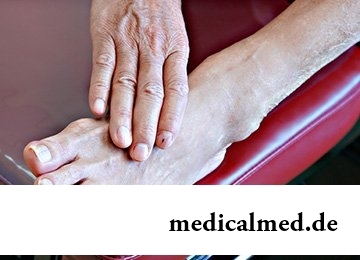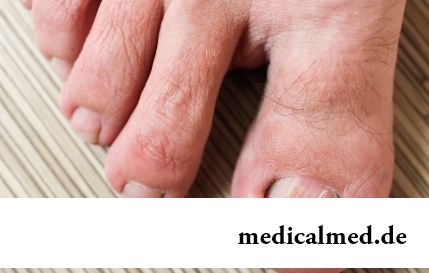





Syndrome to Giyena-Barra
 At the beginning of the XX century researchers Barret, Giyen and Shtrol described an unknown disease at soldiers of the French army. Fighters were paralyzed, they did not note tendon jerks, the anesthesia was observed. Scientists investigated cerebrospinal fluid of patients and defined that in it there was an increased protein content whereas the quantity of other cells was absolutely normal. On the basis of proteinaceous and cellular association what the result of the analysis of spinal liquor testified to, the syndrome which differs from other demyelinating diseases of a nervous system of a rapid current and the favorable forecast was diagnosed to Giyena-Barra. The studied soldiers recovered earlier than in 2 months.
At the beginning of the XX century researchers Barret, Giyen and Shtrol described an unknown disease at soldiers of the French army. Fighters were paralyzed, they did not note tendon jerks, the anesthesia was observed. Scientists investigated cerebrospinal fluid of patients and defined that in it there was an increased protein content whereas the quantity of other cells was absolutely normal. On the basis of proteinaceous and cellular association what the result of the analysis of spinal liquor testified to, the syndrome which differs from other demyelinating diseases of a nervous system of a rapid current and the favorable forecast was diagnosed to Giyena-Barra. The studied soldiers recovered earlier than in 2 months.
Afterwards it became clear that to Giyena-Barra the syndrome is not so harmless what it was described by pioneers. In 20 years prior to emergence of the description of a disease the neuropathologist Landry observed patients with similar diseases. At them the sluggish paralyzes which are promptly developing on the ascending nervous paths were also noted. The prompt course of a disease led to a lethal outcome. Defeat of a nervous system was called Landry's paralysis. Afterwards it became clear that to Giyena-Barra the syndrome can also lead to a lethal outcome due to shutdown of muscular transfer in a diaphragm. But also at such patients the laboratory picture of proteinaceous and cellular association in liquor of the spinal channel was observed.
Then decided to combine both diseases and to appropriate pathologies one name of Landry-Giyena-Barret a syndrome, to this day neuropathologists use the offered terminology. However the international classification of diseases registered only one name: To Giyena-Barra syndrome or acute postinfectious polyneuropathy.
Syndrome to Giyena-Barra, reasons
As the disease develops after an infection, there is an assumption that it causes process of a demiliyenization of nerve fibrils. However the direct infectious agent is still not revealed. On myelin fibers of nervous tissue the antigen antibody complexes which cause destruction of a myelin are postponed.
Myelin covers are located throughout a nervous trunk through certain intervals. They play a role of condensers therefore nervous impulses are transferred quicker in several tens of times and reach "the addressee" in an invariable look. When the syndrome to Giyena-Barra develops, its reasons are cut in decrease in capacity of "condensers". As a result nervous transfer is late and loses force. The person intends to squeeze fingers, but can move them only.
In it essence of all demiliyeniziruyushchy diseases of a nervous system. When at the person the syndrome to Giyena-Barra develops, momentum transfer to the main vitals, such as suffers:
- Cardiac muscle;
- Diaphragm;
- Deglutitory muscles.
At paralysis of these bodies life activity of an organism stops.
Syndrome to Giyena-Barra, symptoms
The paradoxicality of a disease is that at acute development the happy end is the share of two thirds of patients, and at a chronic current the forecast adverse.
To Giyena-Barra the syndrome begins after the postponed acute viral infections, most often, of respiratory. In the form of complications after flu at the person the general weakness which is transferred to hands and legs develops. Afterwards the subjective feeling of weakness progresses to sluggish paralysis. At an acute current the following symptoms develop:
- Disappearance of a deglutitory reflex;
- The paradoxical type of breath – during a breath an abdominal wall does not extend, and on the contrary, will fall down;
- Disturbance of sensitivity of distal departments of extremities as "gloves" and "stockings".
In hard cases breath because of a phrenoplegia is turned off.
When initially chronic syndrome to Giyena-Barra develops, symptoms accrue slowly, within several months, but at manifestation peak they will difficult respond to treatment. As a result of an effect of paralysis remain on for the rest of the life.
Clinical current of a syndrome to Giyena-Barra
During a disease 3 stages are defined:
- Prodromal;
- Heat;
- Outcome.
The prodromal stage is characterized by a febricula, muscular hand and legs pains, slight increase of temperature.
In the period of a heat all symptoms characteristic for Giyena-Barra of a syndrome which reach peak of the development by the end of a phase are shown.
The stage of an outcome is characterized by total absence of symptoms of any infection, but shown only by neurologic symptoms. The disease comes to an end with either a complete recovery of all functions, or disability.
Syndrome to Giyena-Barra, treatment
At the acute beginning, especially when the syndrome to Giyena-Barra at children develops, first of all there are resuscitation actions. Timely connection of the medical ventilator saves the patient's life.
 Long stay in resuscitation chamber demands additional treatment, prevention of decubituses and fight against infections, including, hospital is made.
Long stay in resuscitation chamber demands additional treatment, prevention of decubituses and fight against infections, including, hospital is made.
Uniqueness of a disease to Giyena-Barra is that at adequate artificial ventilation of the lungs there is a regeneration of myelin covers without any medicamentous influence.
Modern methods of treatment of a syndrome to Giyena-Barra, at children in particular, provide carrying out a plasma exchange. Clarification of a blood plasma from autoimmune complexes prevents progressing of demyelination of nerve fibrils and considerably reduces the period of artificial ventilation of the lungs.
Now the syndrome Giyena-Barra will respond to treatment by means of immunoglobulin injections. The method is expensive, but efficient. In the recovery period physical therapy methods, physiotherapy exercises and massage are used.
Except people, only one living being on the planet Earth – dogs suffers from prostatitis. Here really our most loyal friends.

Musicotherapy – a treatment method which caused and causes a set of a controversy concerning its efficiency. However the facts are relentless:...
Section: Articles about health
It is possible to find the extensive range of fruit and vegetables in modern shops. Russians already got used that on counters there is not only a seasonal domestic production, but the vegetables and fruit which are grown up in the countries with more comfortable conditions at all seasons of the year...
Section: Articles about health
The sudden heat on all body which is followed by perspiration and a cardiopalmus – the phenomenon familiar to many people. Most often such states called by "inflows" result from nervous or physical overworks and disappear right after rest. However in certain cases similar reaction of an organism can speak about diseases which need treatment. What? About it below....
Section: Articles about health
Aspirin (acetylsalicylic acid) – one of those drugs which are known literally to all. It is available in each home first-aid kit...
Section: Articles about health
For the person who daily since morning gathers for work it is very important to wake up vigorous and ready by day of work. Actually, each of us experiences difficulties with this, at first sight, simple business from time to time. On a condition of an organism after ночн...
Section: Articles about health
Helminthosis is one of the most widespread diseases. Statistically, any species of helminths infected every third inhabitant of the planet. Most of specialists even consider these data strongly underestimated: some uninvited "cohabitants" do not cause the carriers serious troubles, and patients just do not see doctors. The situation is aggravated also with the fact that people know about specifics of similar illnesses very little. At many presence of worms is strong ассоциир...
Section: Articles about health
Striya (extension) are the defects of skin having an appearance of direct or wavy strips from 1 to 10 cm long and 1-5 mm wide. In the majority with...
Section: Articles about health
We live during an advertizing era. Daily each person receives a solid portion of persuasive councils about what to eat to be healthy and successful. Products about which we will talk today are combined by the following circumstance: all of them are positioned as most...
Section: Articles about health
There comes the season of issues. Many Russians already dream of outdoor recreation, trips, beautiful seaside beaches. At this time there is no wish to think of problems with health and other unpleasant things, however there are subjects which require attention. In the summer repeatedly the risk increases to ache with some very dangerous illnesses, we also will talk about them today....
Section: Articles about health
The endocrine system carries out in a human body extremely important role, practically all processes of life activity регулируютс...
Section: Articles about health
Transfusion of donor blood has almost century history. In spite of the fact that this procedure is quite usual for many people, process of blood donation is still surrounded with numerous myths. Today we aimed to discredit the most widespread of them....
Section: Articles about health
People know that thermal sources have salutary force long ago. Treatment by natural waters is one of the most ancient methods of disposal of the most different diseases. Bathtubs, souls, wrappings and inhalations, in combination with water reception inside help to improve a condition of the patients suffering from disturbances of work of a musculoskeletal system, bodies of digestive tract, cardiovascular, nervous, respiratory and secretory system, skin and endocrine п...
Section: Articles about health
Statistically, at the address to doctors seven of each ten patients complain of a headache. Actually people, periodically...
Section: Articles about health
EKO, or extracorporal fertilization - a method of treatment of infertility which became the reason of a set of broken-down copies in due time accused the people working on its creation neither more nor less of rivalry good luck. Already very few people deny the rights...
Section: Articles about health
Scientists have no unambiguous opinion on a proximate cause of emergence of a carcinoma cutaneum today. Only the factors promoting development of this illness are precisely established. Treat them: long impact on skin of ultraviolet rays, radiation exposure, thermal injuries, injuries of skin by aggressive chemicals (pitches, acids, alkalis, etc.), genetic predisposition (existence of malignant new growths of skin in the family anamnesis), at...
Section: Articles about health
Feeding by a breast - the integral part of ideal motherhood allowing to come into contact with the kid and to create since early years...
Section: Articles about health
The name of this disease precisely reflects the problem reason: it consists in the bra fastener pressure upon a certain zone of a back. At the same time one of vertebrae of chest department of a backbone is as if blocked and loses mobility, and falling on it is nude...
Section: Articles about health
On health of the person physicians know about salutary action of animals long ago. About 7 thousand years ago great Hippocrates recommended to the patients riding walks for strengthening of a nervous system and increase in vitality....
Section: Articles about health
What woman does not dream of a beautiful and thick hair? So far physicians developed difficult schemes on hair transplant, in the bet industry...
Section: Articles about health
The number of long-livers is very small. One person from 5 thousand lives up to age of 90 years, and the centenary boundary steps over only one of 20 thousand. However, doctors claim that each of us is quite able to affect own destiny. At the same time speech to Ida...
Section: Articles about health
All like to sing. Small children with pleasure are engaged in a vocal, not especially thinking of hit in a melody. Adults most often hesitate, being afraid to show lack of talents in this area, and it is vain: singing is very useful for health....
Section: Articles about health
The word "onikhokriptoz" is unfamiliar to most of people, meanwhile quite so physicians call very widespread problem: growing...
Section: Articles about health
The dietology, as well as other sciences, does not stand still. Food stuffs are exposed to comprehensive study, and scientists obtain new information on their properties and influence on a human body. Unfortunately, this reasonable and natural process from time to time д...
Section: Articles about health
Obesity is called a disease of 21 centuries, for the last 100 years the number of the people suffering from excess body weight considerably increased. Statistically, on Earth already about 1,5 billion corpulent people, and 500 million from them have the extreme degree of completeness negatively affecting quality and duration of their life. What served as the reason of growth of stout persons on the planet? How not to get to their ranks? Let's consider five main premises for increase in body weight in conditions современнос...
Section: Articles about health
Some people consider what for medicine of the 21st century of secrets in the field of health of the person almost does not exist. It absolutely not so. Than Bol...
Section: Articles about health
Long time antibiotics were considered as a panacea from all diseases and were appointed even at insignificant symptoms of an infection. Even now not everyone knows in what force of antibiotics how and when they should be accepted. Let's discredit 7 popular myths about such drugs...
Section: Articles about health
The kid who was recently born is surrounded with love of adult family members and their cares without which the baby cannot exist. Some parents consider that gentle attachment and caress are quite enough that the child correctly developed and was happy, but it not so. It is important to know as much as possible about specifics of care of the baby, the reasons of his behavior and possible problems. Only the "able to see" love will provide to the little man that it is necessary for him....
Section: Articles about health
